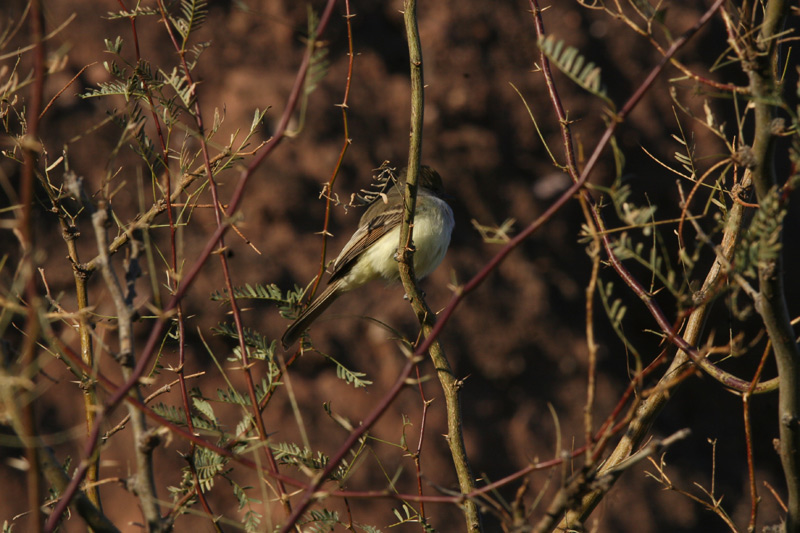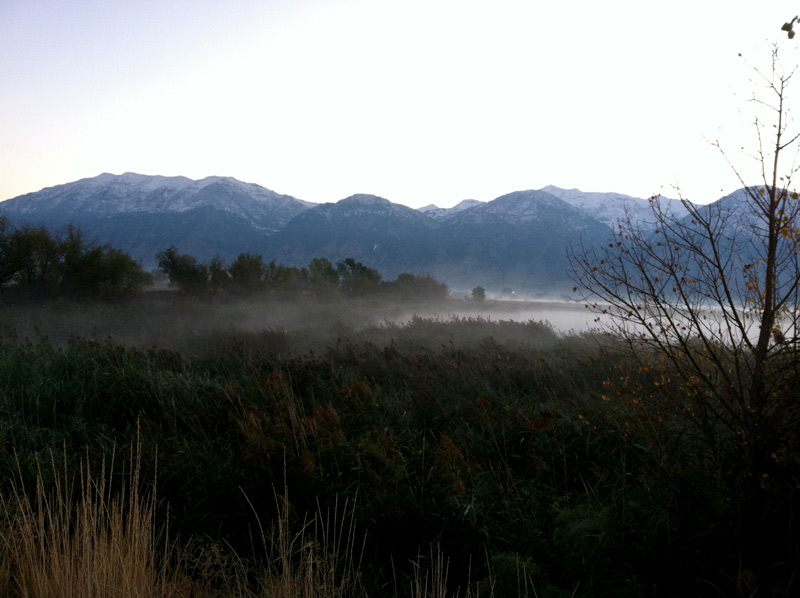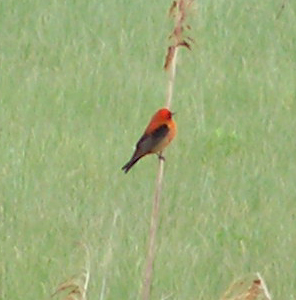Utah County Birders Newsletter
|
 |
Contents
February Meeting
Upcoming Field Trips
President's Message
Bird of the Month
2012 UCB Birding Challenge
Provo Airport Dike Big Year
Field Trip Report
- Jordan River
Backyard Bird of the Month
January Hotline Highlights
FEBRUARY MEETING:
Thursday, February 9th, 2012
"The Beautiful Birds Of Fiji" - presented by
Doug Mead. It should be very informative and entertaining.
Meet at 7:00 PM in the Bean Museum Auditorium on the BYU Campus.
Saturday, Feb 4th, 2012
Farmington Bay and
Lee Kay Ponds -
led by Jeff Cooper. Meet at the Park and Ride on the west side of I-15 at exit
284 (Thanksgiving Point) at 7:30 a.m. we will be back around 1:00 p.m. Please
contact Jeff if you plan to attend - jeffcooper7@gmail.com.
Saturday, Feb
18th, 2012
Salt Lake County -
led by Keeli Marvel. We'll work on our Salt Lake County species lists by
checking out Lee Kay, the Jordan River, and various community fishing ponds in
Salt Lake County. Target species include Greater White-fronted Geese and
Barrow's Goldeneye. Meet at the American Fork Main Street Park and Ride at 8am
(on Pioneer Crossing on the west side of I-15). We'll be back around noon.
Saturday, Feb 25th, 2012
Delta Snow Goose Festival -
led by Bryan Shirley. Meet at the Payson Walmart at 7 AM (2nd Payson Exit). From
there we will car pool to delta as much as possible. We will be visiting
Gunnison Bend Reservoir for Snow & Ross's Geese. If you are working on the
challenge for the year, we should be able to knock off your species for Juab
County. Plan on being gone most of the day.
We are actively recruiting people to lead local half-day field trips, any time,
any place. If you would like to lead a field trip or if you have any ideas for
this year’s field trips, please contact Keeli Marvel at - keeli.marvel@gmail.com.
by Bryan Shirley, UCB President
Don’t believe everything you read
Last month on birdtalk there were some pictures and a discussion about a falcon
that had tried to kill a snake. Here is the link to the page on Utahbirds:
http://utahbirds.org/ThisAndThat/SnakeRiver.htm. The snake somehow got
wrapped around the falcon’s neck, then started biting the birds leg. The
reporter said that he found them like this floating in the Snake River. Several
people here in Utah were quick to point out several errors with this story.
First of all, this bird isn’t a falcon. So I understand that this isn’t a birder
telling this story, so we can let that one slide. After all, I admit I am not
sure what this bird is from the photos. The big thing that jumped out (to those
people who know snakes) was that there was no way this could be on the Snake
River. The snake apparently is a Texas Rat Snake or Texas Fox Snake and is only
found in around Texas. At least this story had pictures, so we know that there
at least was a bird and a snake. That much appears to be real. There are worse
stories out there.
A few months ago a friend, who I thought he knew a lot about birds, was getting
ready to give a presentation to a large group of co-workers. He had found an
inspirational story about Bald Eagles. He was all ready to go, but then he
happened to run into me and told me about his inspirational talk about birds.
Imagine this with music and great photos of Eagles – some Bald Eagles and some
Golden Eagles (I think Goldens are supposed to be very run-down Bald Eagles).
The story of the eagle - This is incredible!
The eagle has the longest life-span of its' species It can live up to 70 years.
But to reach this age, the eagle must make a hard decision in its' 40's.
Its' long and flexible talons can no longer grab prey which serves as food.
Its' long and sharp beak becomes bent.
Its' old-aged and heavy wings, due to their thick feathers, become stuck to its' chest and make it difficult to fly.
Then, the eagle is left with only two options: die or go through a painful process of change which lasts 150 days.
The process requires that the eagle fly to a mountain top and sit on its' nest.
There the eagle knocks its' beak against a rock until it plucks it out. After plucking it out, the eagle will wait for a new beak to grow back and then it will pluck out its' talons.
When its' new talons grow back, the eagle starts plucking its' old-aged feathers.
And after five months, the eagle takes its famous flight of rebirth and lives for 30 more years.
Learn from the Eagle.
Spread Your Wings and Fly.
I think about every line in this presentation has something wrong with it. I
don’t know how long an Eagle lives, but I would guess that a 30 year old eagle
is pretty dang old. Not sure what they mean by the eagle having the longest
lifespan of its species. The beak and talon is similar to human fingernails –
they are continuously growing. I didn’t add the photo, but the real presentation
shows a healthy beak – they are all curved or hooked at the end. If you see one
that isn’t that is a problem. Eagles molt feathers like most birds – a little at
a time and they don’t ever lose the ability to fly (waterfowl does molt their
flight feathers and have a period where they can’t fly, but they can still swim
so they still are eating during this time). 5 months without feathers, a beak,
or talons, then the ‘famous flight” of rebirth? Really? Plus remember this is
all the choice of the eagle – some go through this process, but others decide to
throw in the towel when they are about 40.
Last week I started reading the Harry Potter series (never finished all 7 books
and now I can’t remember which ones I read last time). In Harry Potter & the
Sorcerer’s Stone I just learned about the Phoenix, a really cool bird that burns
up and then is reborn from the ashes. Put that in a power point presentation and
you have a great inspirational story! I would try using a Bald Eagle instead of
a Phoenix though – more powerful –looking bird and a heck of a lot easier to get
photos of!
 |
Nutting's Flycatcher (Myiarchus nuttini)
by Dennis Shirley
On December 18, 2011 an ABA Code 5 Nutting's Flycatcher (Myiarchus nuttini) was
found in a riparian area of the Bill Williams' River National Wildlife Refuge in
west central Arizona. The Bill Williams' River NWR is along a tributary to the
Colorado River south of Lake Havasu City. This was the fifth confirmed record of
Nutting's Flycatcher in the ABA area. All sightings have been in the winter,
with one in southern California and four in Arizona. The California bird was in
2001. I believe that Ned Hill saw this bird, and that it was his 701 ABA bird.
The species is normally a resident from northern Costa Rica to central Mexico.
The Nutting's Flycatcher is a typical Myiarchus flycatcher. It most closely
resembles the Ash-throated Flycatcher and Brown-crested Flycatcher. Its most
distinguishing field marks are its cinnamon edging, tending towards yellow on
its wing secondaries; brownish face; bright yellow belly; more olive colored
back; and small bill. The National Geographic field guide has the best picture
of this bird.
On January 5, 2012, after watching the internet reports for about three weeks, I
made a quick dash to the staked-out location. I drove straight through via I-15,
St. George, Las Vegas, Kingmon, Arizona, and Lake Havasu City, leaving at 5:00
a.m. and arriving at 1:30 p.m. The spot was easy to find because of good
directions, and two carloads of birders were there when I arrived. The bird had
been briefly seen in the morning, but not since. Its "MO" was normally to hang
around a roost area in the early morning, leave during the day into the thickets
along the Bill Williams' River, and return late in the afternoon. Other birders
started arriving about 3:30 including Lauren Hartly, the birder who originally
found it. True to form, about 4:00 p.m., Lauren heard it calling in the thick
mesquite and willows along the river. For the next hour or so, we followed its "wheep"
calling until it finally worked its way out along the edge and we were able to
get good looks at it.
I had taken my cameras with me and wanted to get some good pictures. Since it
was after sundown, I decided to camp on the desert nearby and return the next
morning. At daylight the next morning, I was again at the location where I left
it the night before. Sure enough, as it began to warm up, the "wheep" calling
started. With a new group of birders, we were able to get close, dynamite looks
and several good photos of the bird. It turned out to be a successful and easy
chase which resulted in my 714th ABA bird. The bird is still there today.
If you would like to write an article for the Bird of the Month, please contact Oliver Hansen -- 801-378-4771 - byucactus@gmail.com .
Click here for past 'Birds of the Month'.
2012 Utah County Birders Birding Challenge.
Every other year the UCB issues a birding challenge - goals that will hopefully
get people out in the field birding.
Visit
http://www.utahbirds.org/ucb/BirdingChallenge2012.pdf for this year's UCB
Birding Challenge.
2011 Provo Airport Dike Big Year
by Eric Huish
 |
 |
 |
Last Year KC Childs and I decided to do a Big Year, a different kind of Big
Year, a Big Year that didn't require us to spend all of our free time driving to
distant locations. We did a Provo Airport Dike Big Year. It was a convenient
spot I could visit close to work. I visited the dike 122 times last year and saw
164 species (KC saw 146 species). My PAD life list climbed to a over 200
species. Most of my 122 visits were early morning visits before I had to be to
work at 8:00.
We had a couple of setbacks that I believe hurt our numbers some. We had extra
high water levels all year and the dike was closed for a couple of months due to
an ice flow that covered the road in February and March.
On February 16th KC and I we walking on the east side of the dike when a very
strong wind blew in. I couldn't hold the scope steady or keep my eyes from
watering so we decided to head back the the car and continue around the dike.
When we made to the Southwest corner the
road was completely blocked by Mountains of ice that had built up 15 feet high
covering at least a few hundred feet of the road and spilling over into the
moat. There were torso sized boulders 6 feet high in the piles of ice. It was
pretty cool to look at. The next day there were police barricades blocking most
of the dike loop. The dike was closed for almost 2 months.
In past year's there is sometimes a mudflat that attracts shorebirds to the
dike. The high water meant no mudflats so shorebirds were much harder to find.
If we walked down the gated road on the east side of the dike we could find
shallow water with a shorebird or two but it was in an overgrown grassy field,
not a mudflat. The flooded field was perfect for Sandhill Cranes, a pair of
cranes raised a chick out there last year.
Sometimes the birds were the same day after day and sometimes it was surprising
to see what a difference a day could make. On May 30 KC and I had planned on
heading out to Lake Mountain, but when we met that morning it was windy, cold
and hailing so we decided to stay close to home and birded the Airport Dike
instead. At the dike, in the wind, rain and hail, there was a bird 'fallout'.
Hundreds of Tanagers were feeding near and on the ground out of the wind, one of
them was a male Scarlet Tanager. There were several Hermit and Swainson's
Thrushes in the woods at the north end of the dike, dozens of Olive-sided
Flycatchers and we also found a Red-eyed Vireo. What we thought would be a
horrible day birding turned out to be great.
We missed many birds that others saw out there, but I was happy with some of the
great birds we did see. It was a very rewarding year of birding.
eBird shows a list of 182 species total reported for 2011
Highlight Birds I saw on the PAD in 2011 -
Snow Goose - 18 Feb 2011
Tundra Swan - 01 Feb 2011
Hooded Merganser - 02 May 2011
Horned Grebe - 09 Oct 2011
Short-eared Owl - 06 Dec 2011
Northern Saw-whet Owl - 30 Jan 2011
Common Poorwill - 27 May 2011
Vaux's Swift - 09 Oct 2011
Scissor-tailed Flycatcher - 06 Jun 2011
Northern Shrike - 07 Jan 2011
Red-eyed Vireo - 30 May 2011
Purple Martin - 17 May 2011
Northern Mockingbird - 03 May 2011
Northern Waterthrush - 05 Sep 2011
Northern Parula - 14 May 2011
Blackpoll Warbler - 11 Oct 2011
White-throated Sparrow - 01 Nov 2011
Scarlet Tanager - 30 May 2011
Blue Grosbeak - 06 Jun 2011
Cassin's Finch - 26 Apr 2011
Just a few of the birds seen on the dike in 2011 that I missed -
Green Heron - reported by Carol Nelson
Lewis's Woodpecker - Jeff Bilsky
Hairy Woodpecker - Robert Williams
Ash-throated Flycatcher - Dennis Shirley
Black-throated Sparrow - Jeff Cooper
Sage Sparrow - Jack Binch, Robert Williams
Field Trip Report
Jordan River Parkway, Saratoga Springs - 21 January 2012
by Eric Huish
On January 21st 15 Utah County Birders met for a Field Trip. We walked the
Jordan River Parkway in Saratoga Springs as planned even though it was raining.
It rained the entire morning. We birded the fields west of Inlet Park, walked
around Inlet Park a little, then walked the Jordan River Parkway from the model
airfield north to the old pump house. Birds were not abundant and we were all
soon soaked. We ended up cutting the trip short. Trip highlights were a close
look at a Great Horned Owl along the parkway north of the model airfield and a
Bald Eagle at Mill Pond on our way out to the Jordan River Parkway.
List below.
Canada Goose 100 Flying in the distance.
Northern Shoveler 5
Common Goldeneye 1
duck sp. 50 Flying in the distance.
Pied-billed Grebe 2
Great Blue Heron 1
Bald Eagle 1
Sharp-shinned Hawk 1
Red-tailed Hawk 1 Dark morph.
American Coot 7
Rock Pigeon 150
Great Horned Owl 1 Down the dirt loop trail west of the old pump house, north of
the model airfield.
Northern Flicker (Red-shafted) 10
Black-billed Magpie 3
Black-capped Chickadee 2
American Robin 1 Heard Only
European Starling 100
Spotted Towhee 1
Song Sparrow 1
White-crowned Sparrow 10
Red-winged Blackbird 50
January 2012
Dennis Shirley – Elk Ridge
My "Bird -of-the-Month" is 11 MULE DEER, who have acquired a taste for,
and are continually emptying, my black-oil sunflower seed and cracked corn
feeders.
Steve Carr - Holladay
Cooper's Hawk - Species number 15 for my yard this year.
Bruce Robinson – West Jordan
Downy Woodpecker - I heard it pecking in a tree and found it about 4 feet
above me
Milt Moody - Provo
I had a Yellow-rumped Warbler in my apple tree.
Reed Stone – Provo
My exciting yard bird was a GREAT HORNED OWL spent the day in my backyard
tree.
Eric Huish - Pleasant Grove
Western Screech-Owl - always fun to see.
Carol Nelson - Provo
The male Hooded Merganser continues to have his daily swim on the pond
behind our home. He has been joined by a few Wigeons and a pair of
Gadwalls, but 50 Magpies congregating on the back lawn caught my attention
the other day. Glad my feeders were virtually empty and no peanuts were out.
Cheryl Peterson – Provo
Sharp-shinned Hawk
2012 Dues
Thanks to all who have supported us in the past. If you are interested in officially joining us this year, make out a check to Utah County Birders for $15.00 and mail it to:
Carol Nelson
2831 Marrcrest West
Provo, Utah 84604
You will be helping to support the web page and we will send you a copy of the newsletter.